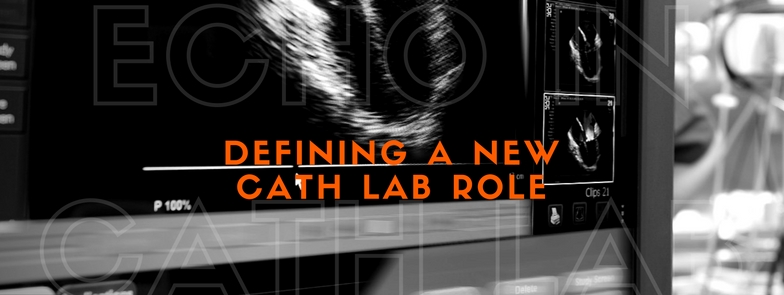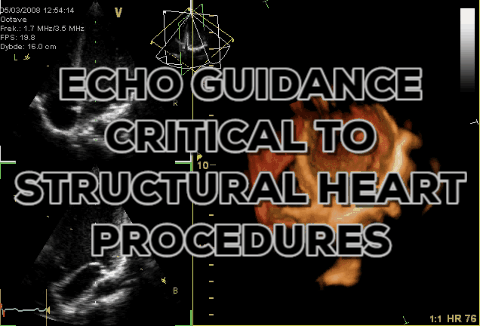Structural heart procedures are growing, and so is the cath lab team.
For two straight years, Diagnostic and Interventional Cardiology (DAIC) magazine has reported from the American Society of Echocardiography (ASE) Annual Scientific Sessions on the rise of a new sub-specialty—interventional echocardiography.
Interventional echocardiography crucial to structural heart
Structural heart procedures have seen rapid growth in the cath lab—and have been a featured topic at many of our 2016 regional educational conferences—and for all but the most expert interventionalists, echocardiography plays a big role in those cases.
Just last week, for example, ACVP Blog discussed a new transcatheter technology that successfully repaired a leaky tricuspid valve. Echo guidance was critical to the procedure.
At ASE 2016, Rebecca Hahn, MD, FASE, an expert in interventional echocardiography from Columbia University Medical Center, spoke with DAIC editor Dave Fornell regarding the role of an interventional echocardiographer in the cath lab.
"If you were to come into our lab and watch a case, you would hear me speaking almost as much as the interventionist," said Hahn. "It's that team mentality that really allows us to communicate... You cannot afford to not have the echocardiographer intimately involved with the procedure every step of the way."
In an earlier DAIC interview from ASE 2015, Hahn argued that echo is essential to better outcomes for structural heart procedures, especially in lower volume centers. "It can not only make it more accurate, but it can make the procedures shorter, reduce the amount of radiation, as well as the amount of contrast, and as you know contrast plays into outcomes." she said. "Once 3D TEE was being used for the MitraClip, for instance, those procedures then became much faster and much more accurate."
For high volume, expert structural heart centers, interventionalists may feel comfortable enough with certain procedures to forgo echo guidance, but for "new and novice centers," said Hahn, "the need for transesophageal imaging as a safety net becomes even greater."
"You need to have every tool in your toolbox to help ensure outcomes," said Hahn.

Qualifications and requirements still to be defined
As with any new sub-specialty or interventional team member, qualifications for interventional echocardiographers still need to be defined according to Hahn and expert Stephen Little, MD of Houston Methodist DeBakey Heart & Vascular Center.
"You need to be very facile in both 2D and 3D echo, but it's not simply a mastery of 2D/3D echo," said Little to DAIC. "You also need to know what 3D echo can't do and when you have to go to 2D."
Of course, you also need to understand the cath lab and its procedures. "What are the steps and what is your role in those procedures," said Little.
Not only do the echocardiographers have to become oriented to the cath lab—the entire cath team has to come to understand echocardiography as well through team-based in-service training, said Hahn.
But what about reimbursement?
Another major question facing this new sub-specialty is is the reimbursement structure for the cath lab—does it need to change before hiring a dedicated interventional echocardiographer makes sense? Yes, said Hahn and Little.
"You really can't justify it on a fee-for-service because the fee codes do not justify the time spent in the cath lab," said Little to DAIC. "So, it tends to be a hospital decision because it is good for quality, and it is good for outcomes, but a center needs to have volume to make that happen."
And even at high volume centers, an echocardiographer's caseload might drop significantly. "We will do six TAVRs in a day, but the reimbursements, even for a pre- and a post-TEE study, are not going to be the same as what I can do in a lab, where I can do anywhere from 25 to 40 regular studies," said Hahn. In a Relative Value Unit physician compensation system, it doesn't make sense.
There's also the question of new technology—will new devices continue to fuel a push for echo guidance in the cath lab, or will they innovate around echo for cost savings?
Despite questionable funding and more unknowns surrounding interventional echocardiography, demand for the education was significant. In 2016, only the first year ASE offered courses specifically geared toward this new sub-specialty, they sold out of spaces.
What do you think? Is your cath lab working with structural heart procedures? How are you integrating echo guidance?

That’s interesting that not only does the electrocardiographer need to become oriented in the cath lab, but the cath team needs to understand their work as well. This would be smart as both parties can then work together to help work on people’s hearts. Plus, it would give the patient more comfort to know that the entire team knows how to understand the readings and care for them.